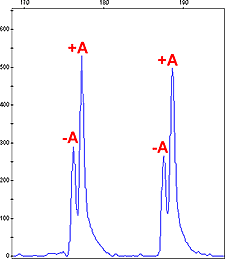Archival Notice
This is an archive page that is no longer being updated. It may contain outdated information and links may no longer function as originally intended.
Home | Glossary | Resources | Help | Contact Us | Course Map
If too much input DNA is added to an amplification reaction, the polymerase may be unable to complete the extension for all amplicons.03 Non-template addition results in a PCR (Polymerase Chain Reaction) product that is one base pair longer than the actual target sequence. When the polymerase is unable to complete the adenine addition on all products, this results in what is commonly referred to as split peaks (+A/-A peaks).01 To minimize split peaks, the extension phase of the PCR process is designed to drive the addition of adenine, ensuring that all amplicons are the same length. Kit manufacturers have also developed primer sequences that encourage adenine addition.
Read more about PCR in course: Crime Scene and DNA Basics for Forensic Analysts.
Note: |
|---|
| Samples displaying -A can be diluted with buffer and reextended in the thermal cycler. |
Additional Online Courses
- What Every First Responding Officer Should Know About DNA Evidence
- Collecting DNA Evidence at Property Crime Scenes
- DNA – A Prosecutor’s Practice Notebook
- Crime Scene and DNA Basics
- Laboratory Safety Programs
- DNA Amplification
- Population Genetics and Statistics
- Non-STR DNA Markers: SNPs, Y-STRs, LCN and mtDNA
- Firearms Examiner Training
- Forensic DNA Education for Law Enforcement Decisionmakers
- What Every Investigator and Evidence Technician Should Know About DNA Evidence
- Principles of Forensic DNA for Officers of the Court
- Law 101: Legal Guide for the Forensic Expert
- Laboratory Orientation and Testing of Body Fluids and Tissues
- DNA Extraction and Quantitation
- STR Data Analysis and Interpretation
- Communication Skills, Report Writing, and Courtroom Testimony
- Español for Law Enforcement
- Amplified DNA Product Separation for Forensic Analysts


